Multi-Saliency Aggregation-Based Approach for Insulator Flashover Fault Detection Using Aerial Images
Abstract
:1. Introduction
2. Insulator Target Detection Based on F-PISA Algorithm
2.1. F-PISA Algorithm
2.1.1. Color Feature of Target
2.1.2. Structure Feature of Target
2.1.3. Generation of Final Saliency Image
2.2. Morphological Processing
2.3. Determination of Target Area
3. Location of Insulator Flashover Based on Saliency of Color Feature
3.1. Color Determination
3.2. Detection of Fault and Location of Damaged Area
4. Experimental Results and Performance Analysis
4.1. Experimental Results
4.2. Robustness Analysis
4.2.1. Insulators with Indistinct Fault Features
4.2.2. Aerial Images with Different Shooting Distances
4.2.3. Performance Comparison against the Edge Contour Algorithm
4.3. Real-Time Performance Assessment
5. Conclusions and Future Work
- Strong robustness. The proposed algorithmic solution can accurately identify the flashover faults based on the aerial images captured with different shooting distances and angles.
- Good detection accuracy. The flashover fault can be accurately detected even when the boundary between the damaged part and the normal part is not obvious, or the area between the insulator and the partially damaged area is small. The average detection rate can reach up to 92% and the efficient detection rate of the fault location can reach up to 85%.
- Good real-time performance. No complicated calculation is needed by the proposed algorithm, and only the multi-saliency algorithm and the simple mathematical morphology algorithm are used, which ensures the detection effectiveness and minimizes the calculation time at the same time. In addition, the proposed method opens up the possibility of real-time detection for future applications.
Acknowledgments
Author Contributions
Conflicts of Interest
References
- Han, Z.X.; Qiao, Y.H.; Sun, Y.; Li, W. Research on image recognition based insulator fault detection method for UVA transmission line. Mod. Electron. Tech. 2017, 40. [Google Scholar] [CrossRef]
- Wang, L.; Wang, H.G. A survey on insulator inspection robots for power transmission lines. In Proceedings of the 4th International Conference on Applied Robotics for the Power Industry (CARPI), Jinan, China, 11–13 October 2016; pp. 1–6. [Google Scholar] [CrossRef]
- Yan, T.T.; Yang, G.D.; Yu, J.Z. Feature fusion based insulator detection for aerial inspection. In Proceedings of the 36th Chinese Control Conference (CCC), Dalian, China, 26–28 July 2017; pp. 10972–10977. [Google Scholar] [CrossRef]
- Koo, J.H.; Shin, W.J.; Oh, D.H.; Hwang, R.; Lee, B.W. Comparison of Surface Flashover Characteristics of Rod and Rib Type Post Insulator for Extra-High Voltage Superconducting Fault Current Limiter. IEEE Trans. Appl. Supercond. 2017, 27, 1–5. [Google Scholar] [CrossRef]
- Kezunovic, M. Smart Fault Location for Smart Grids. IEEE Trans. Smart Grid 2011, 2, 11–22. [Google Scholar] [CrossRef]
- Saranya, K.; Muniraj, C. Separation of transmission line insulator flashover from a three phase fault using synchronous measurements for a Smart Grid. In Proceedings of the International Conference on Energy Efficient Technologies for Sustainability (ICEETS), Nagercoil, India, 7–8 April 2016; pp. 503–508. [Google Scholar] [CrossRef]
- Sun, X.L.; Zhong, H.H.; Xun, T.; Zhang, J. Effects of surface “micro-holes” on the flashover properties of a disk-type ceramic-vacuum insulator. Vac. J. Cit. Rep. 2017, 141, 124–129. [Google Scholar] [CrossRef]
- Yang, X.L.; Li, Y.Q.; Liu, Y.P.; Lv, F.C. Ultraviolet Image Extraction of Power Equipment Discharge Region Based on Mathematical Morphology. Power Syst. Technol. 2008, 32, 96–99. [Google Scholar] [CrossRef]
- Wang, S.H.; Guo, W.Y.; Lv, F.C.; Liu, Y.P. Quantitative Relation of Ultraviolet Imaging Parameters of Corona Discharge. High Volt. Appar. 2013, 49, 16–20. [Google Scholar] [CrossRef]
- Lei, H.C.; Zang, C.Y.; Jiang, Z.L.; He, S.; Zhao, X.J.; Ye, H.S.; Yin, X.G.; He, Y.J. Detecting Breakage Defect of Post Insulator with Ultraviolet Imaging Method. High Volt. Appar. 2009, 45, 87–91. [Google Scholar] [CrossRef]
- Yin, L.M.; Zhang, D.J.; Tao, Y.Z. Study on Processing Method of Corona Day Blind UV Image Based on Mathematical Morphology. J. Northeast Electr. Power Univ. 2013, 33, 148–151. [Google Scholar]
- Wang, S.H.; Lu, F.C.; Li, H.M.; Yang, X.L. Study of corona UV image segmentation and its application based on mathematical morphology. J. North China Electr. Power Univ. 2009, 36, 18–22. [Google Scholar]
- Jia, B.Y.; Geng, H.R.; Fang, C.H.; Hu, C.; Wang, B.Z. Influence of wind speed and Direction on Flashover Characteristics of Composite Insulators. High Volt. Technol. 2012, 38, 75–81. [Google Scholar]
- Shi, K.Y.; Wang, K.; Lu, J.B.; Lin, L. PISA: Pixelwise Image Saliency by Aggregating Complementary Appearance Contrast Measures with Spatial Priors. In Proceedings of the 2013 IEEE Conference on Computer Vision and Pattern Recognition, Portland, OR, USA, 23–28 June 2013; pp. 2115–2122. [Google Scholar] [CrossRef]
- Pang, M.X.; Ye, X.N.; Ling, Z.H. Saliency Detection Based on Color and Gradient Boolean Feature. J. East China Univ. Sci. Technol. 2016, 42, 91–96. [Google Scholar] [CrossRef]
- Lie, M.M.I.; Borba, G.B.; Neto, H.V.; Gamba, H.R. Fast Saliency Detection Using Sparse Random Color Samples and Joint Upsampling. In Proceedings of the 29th SIBGRAPI Conference on Graphics, Patterns and Images (SIBGRAPI), Sao Paulo, Brazil, 4–7 October 2016; pp. 217–224. [Google Scholar] [CrossRef]
- Cong, R.; Lei, J.; Fu, H.; Huang, Q.; Cao, X.; Hou, C. Co-Saliency Detection for RGBD Images Based on Multi-Constraint Feature Matching and Cross Label Propagation. IEEE Trans. Image Process. 2018, 27, 568–579. [Google Scholar] [CrossRef] [PubMed]
- Kachore, R.N. Detections of salient region by using fast pixelwise image saliency aggregation (F-PISA). In Proceedings of the International Conference on I-SMAC (IoT in Social, Mobile, Analytics and Cloud) (I-SMAC), Palladam, India, 10–11 February 2017; pp. 629–633. [Google Scholar] [CrossRef]
- Achanta, R.; Hemami, S.; Estrada, F.; Susstrunk, S. Frequency-tuned salient region detection. In Proceedings of the IEEE Conference on Computer Vision and Pattern Recognition, Miami, FL, USA, 20–25 June 2009; pp. 1597–1604. [Google Scholar] [CrossRef]
- Achanta, R.; Estrada, F.; Wils, P.; Süsstrunk, S. Salient region detection and segmentation. In International Conference on Computer Vision Systems (ICVS); Springer: Berlin/Heidelberg, Germany, 2008; Volume 5008, pp. 66–75. [Google Scholar]
- Cheng, M.M.; Zhang, G.X.; Mitra, N.J.; Huang, X.; Hu, S.M. Global contrast based salient region detection. In Proceedings of the 2011 IEEE Computer Vision and Pattern Recognition (CVPR), Providence, RI, USA, 20–25 June 2011; pp. 409–416. [Google Scholar] [CrossRef]
- Zhai, Y.; Shah, M. Visual attention detection in video sequences using spatiotemporal cues. In Proceedings of the 14th Annual ACM International Conference on Multimedia, Santa Barbara, CA, USA, 23–27 October 2006; pp. 815–824. [Google Scholar] [CrossRef]

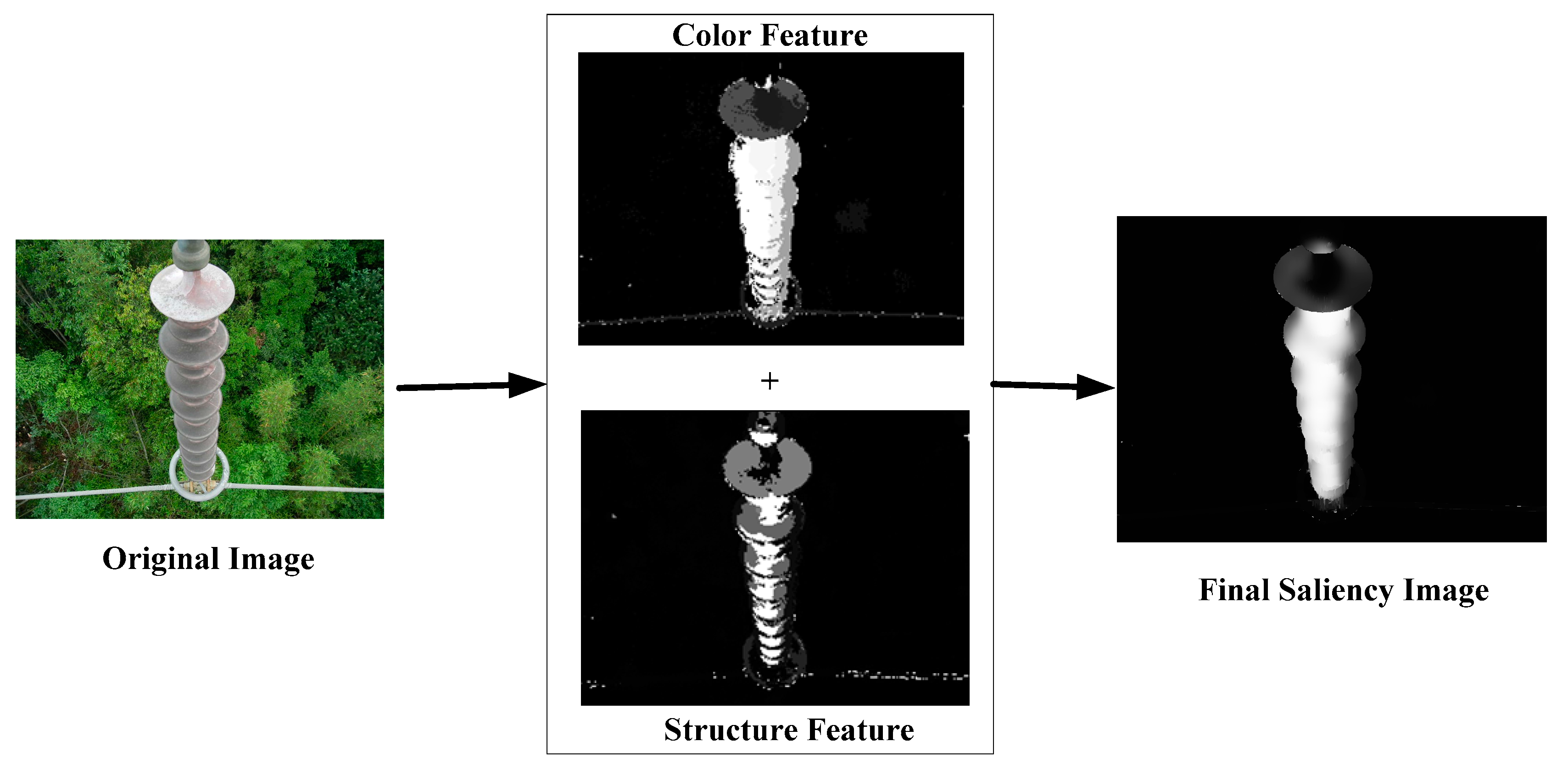
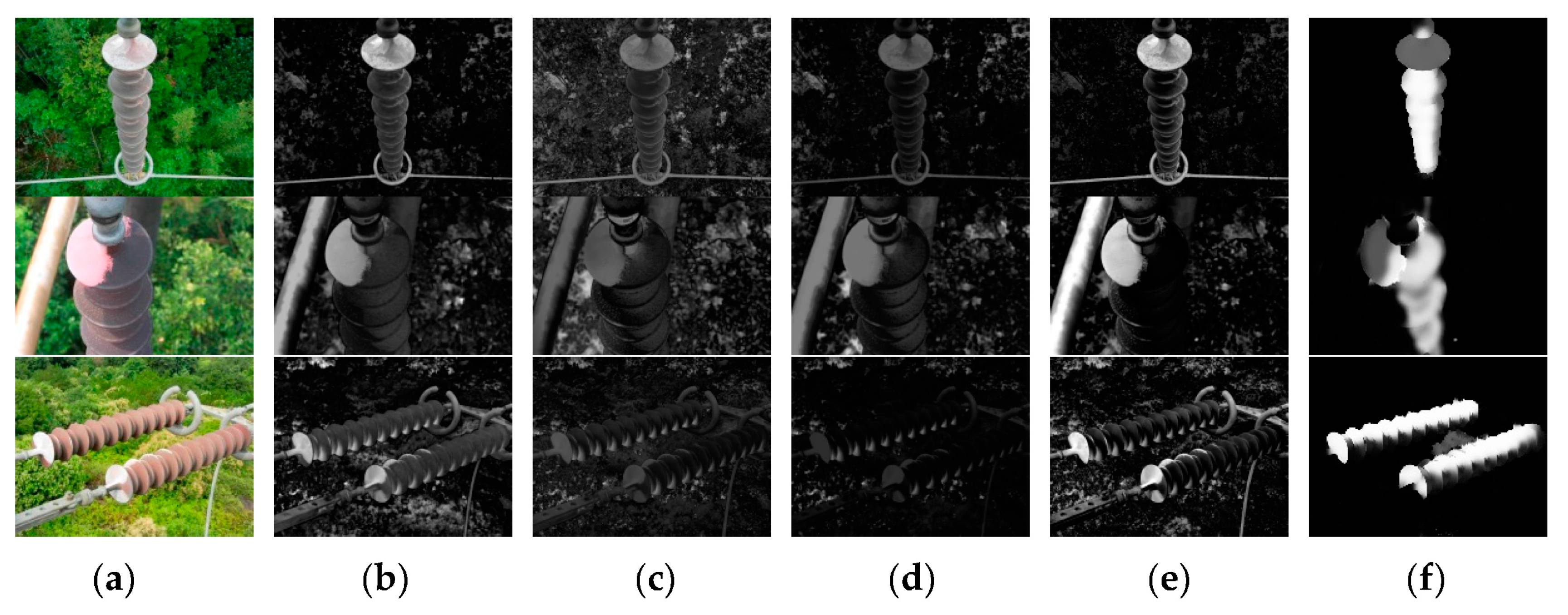
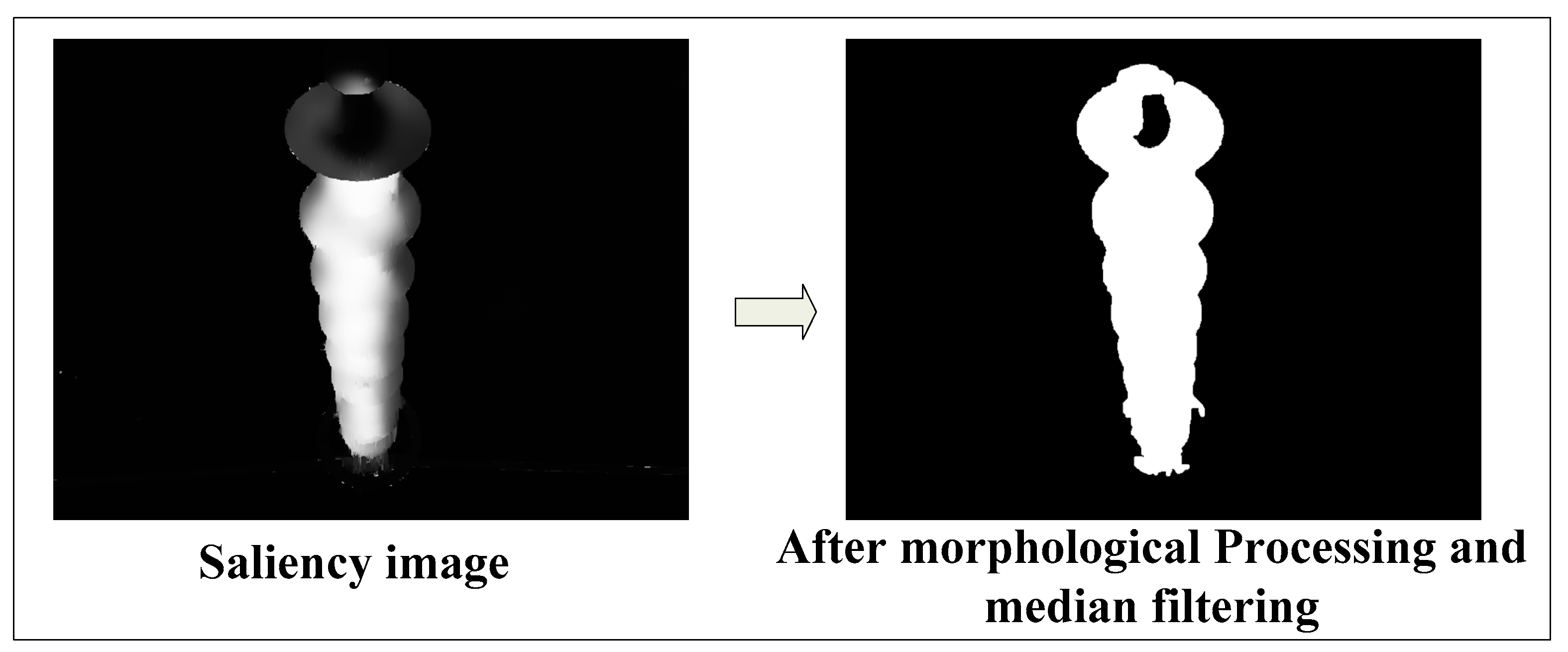
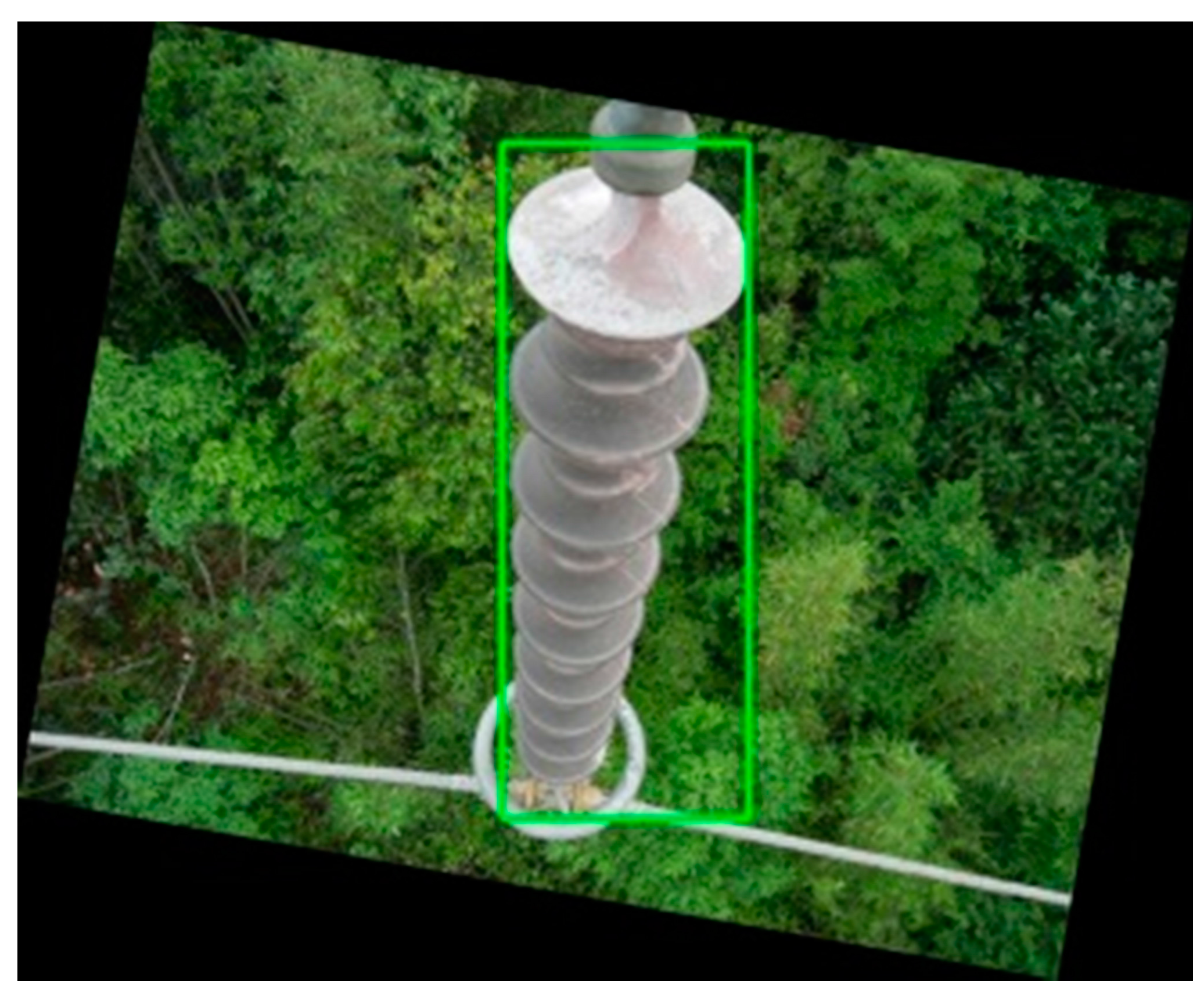
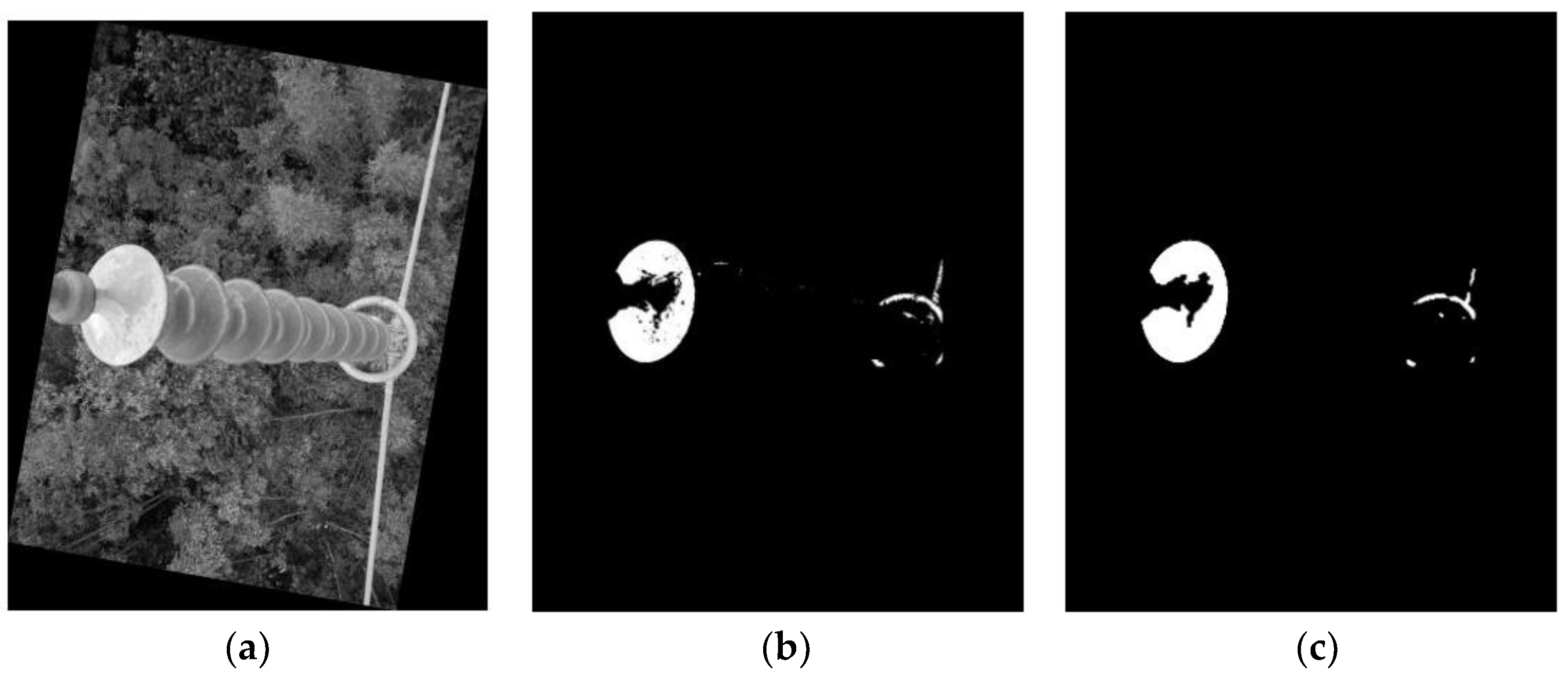
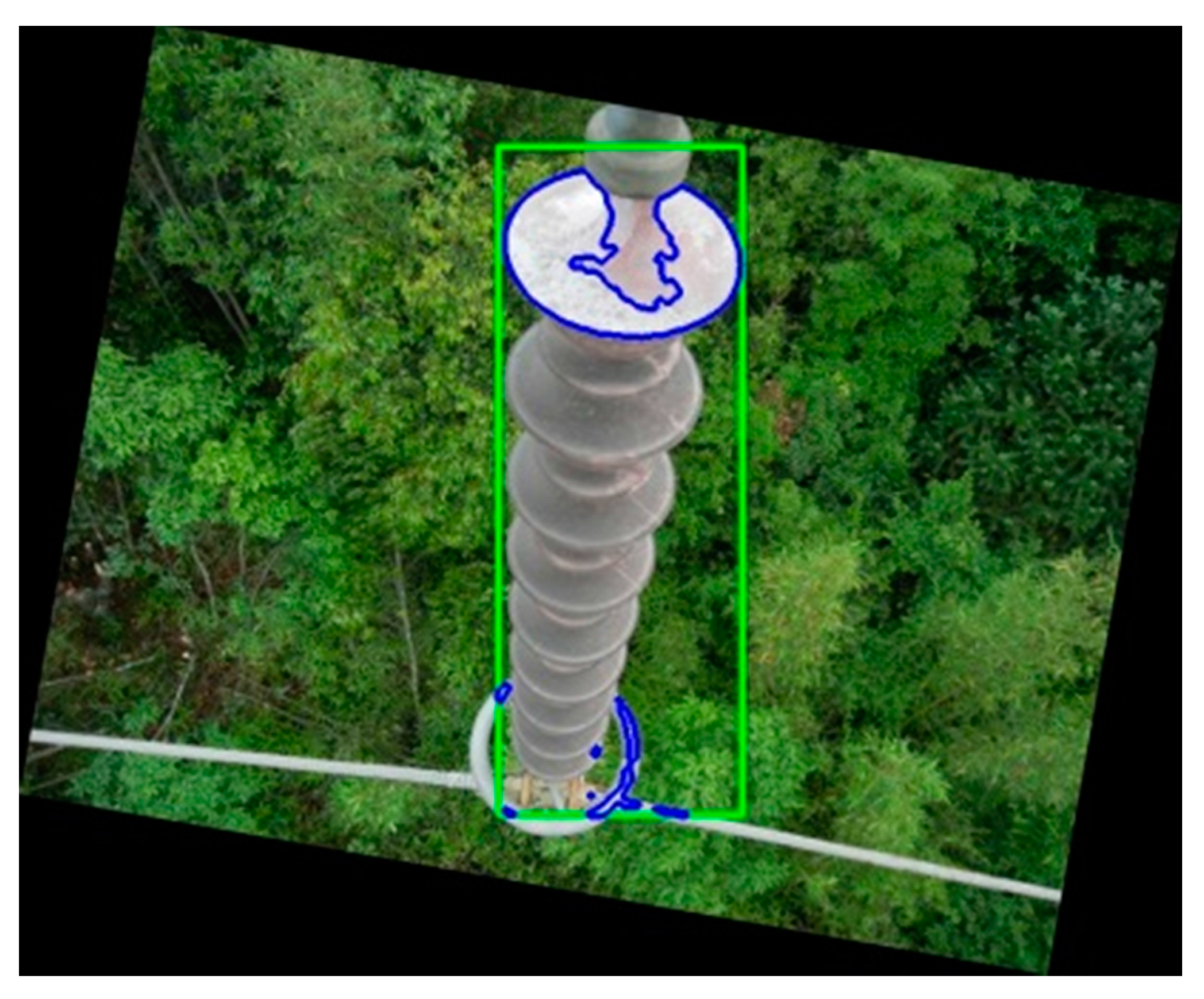

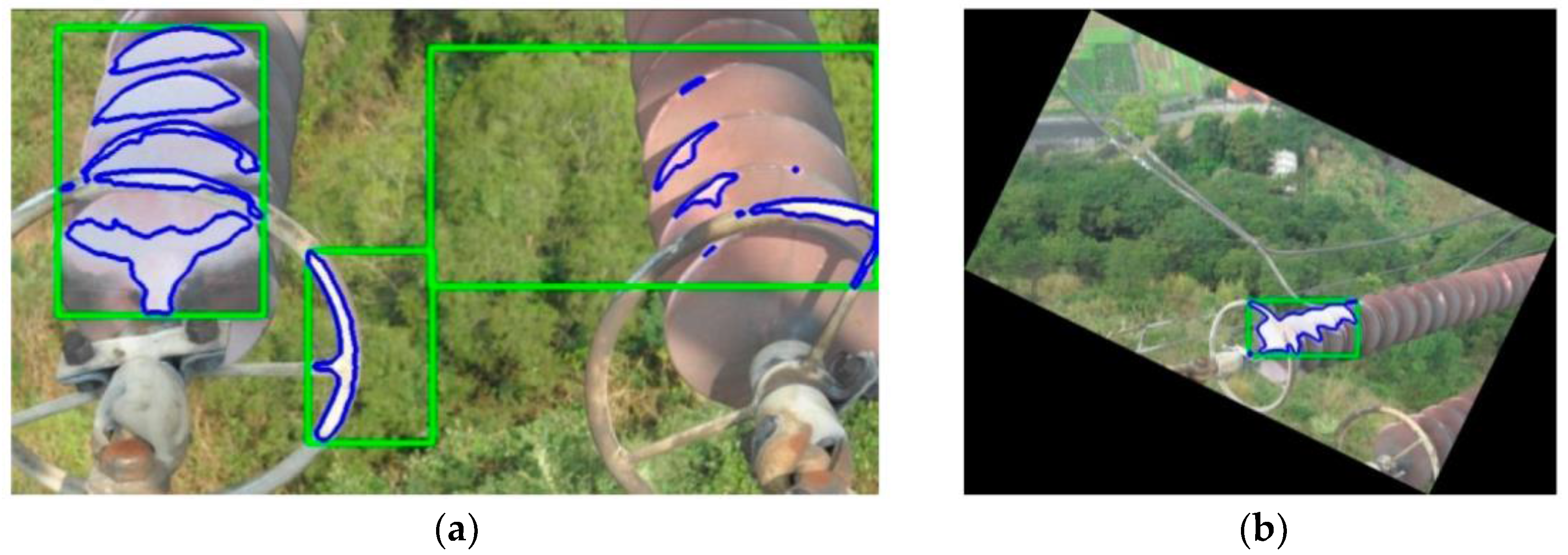
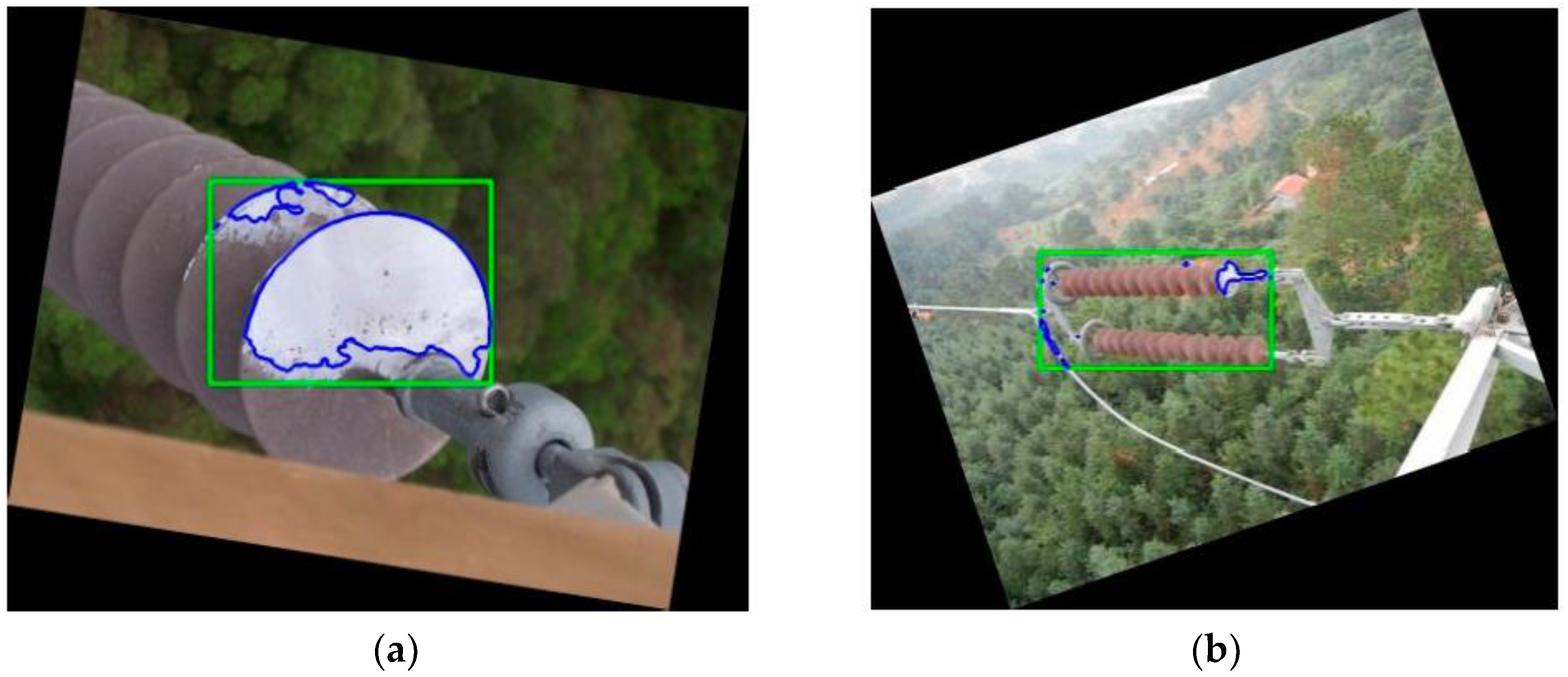

| Different Algorithm | Average Detection Time for Each Image (s) | Average Detection Time for Each Flashover (s) | Detection Rate | Effective Detection Rate |
|---|---|---|---|---|
| Proposed Algorithm | 2.322 | 0.347 | 92.7% | 85% |
| Edge contour Algorithm | 4.658 | 0.486 | 70% | 64.2% |
© 2018 by the authors. Licensee MDPI, Basel, Switzerland. This article is an open access article distributed under the terms and conditions of the Creative Commons Attribution (CC BY) license (http://creativecommons.org/licenses/by/4.0/).
Share and Cite
Zhai, Y.; Cheng, H.; Chen, R.; Yang, Q.; Li, X. Multi-Saliency Aggregation-Based Approach for Insulator Flashover Fault Detection Using Aerial Images. Energies 2018, 11, 340. https://doi.org/10.3390/en11020340
Zhai Y, Cheng H, Chen R, Yang Q, Li X. Multi-Saliency Aggregation-Based Approach for Insulator Flashover Fault Detection Using Aerial Images. Energies. 2018; 11(2):340. https://doi.org/10.3390/en11020340
Chicago/Turabian StyleZhai, Yongjie, Haiyan Cheng, Rui Chen, Qiang Yang, and Xiaoxia Li. 2018. "Multi-Saliency Aggregation-Based Approach for Insulator Flashover Fault Detection Using Aerial Images" Energies 11, no. 2: 340. https://doi.org/10.3390/en11020340
APA StyleZhai, Y., Cheng, H., Chen, R., Yang, Q., & Li, X. (2018). Multi-Saliency Aggregation-Based Approach for Insulator Flashover Fault Detection Using Aerial Images. Energies, 11(2), 340. https://doi.org/10.3390/en11020340






